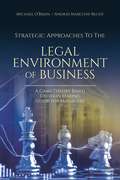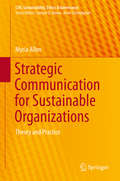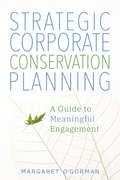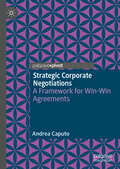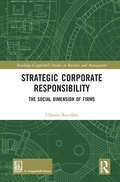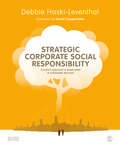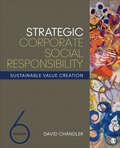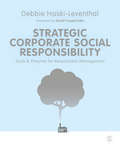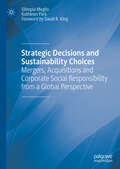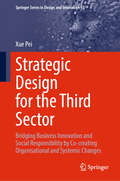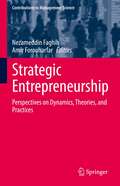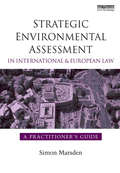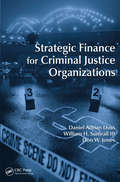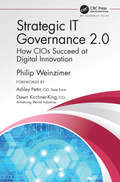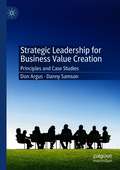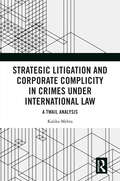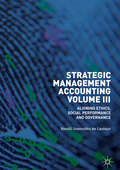- Table View
- List View
Strata Title Property Rights: Private governance of multi-owned properties (Routledge Complex Real Property Rights Series)
by Cathy SherryMulti-owned properties make up an ever-increasing proportion of commercial, tourist and residential development, in both urban and rural landscapes around the world. This book critically analyses the legal, social and economic complexities of strata or community title schemes. At a time when countries such as Australia and the United States turn ever larger areas into strata title/condominiums and community title/homeowner associations, this book shows how governments, the judiciary and citizens need to better understand the ramifications of these private communities. Whilst most strata title analysis has been technical, focusing on specific sections of legislation, this book provides higher level analysis, discussing the wider economic, social and political implications of Australia’s strata and community title law. In particular, the book argues that private by-laws, however desirable to initial parties, are often economically inefficient and socially regressive when enforced against an ever-changing group of owners. The book will be of particular interest to scholars and legal practitioners of property law in Australia, but as the Australian strata title model has formed the basis for legislation in many countries, the book draws out lessons and analysis that will be of use to those studying privately-owned communities across the world.
Strategic Approaches to the Legal Environment of Business: A Game Theory Based Decision Making Guide for Managers
by Michael O'Brien András Margitay-BechtCurrent and future managers are regularly confronted with decisions that create risk in the legal environment of business. This book provides a framework for qualifying legal risk and then determining if the legal risk is worth taking. This framework begins by looking at the relationship between the firm, its suppliers, customers, owners, agents, and others in society as a whole to understand specific risks in personal injury, agreements, products, borrowing money, employees, independent contractors, and business entity selection. When the manager is aware of the magnitude of the risk and the likelihood of the risk, the manager is in a strong position to determine if the risk is worth taking. This book uses numerous applications from Game Theory to determine how risks of the firm compare to risks of another firm, an employee, a vendor and a customer.°Students of business law will appreciate the black letter legal discussions of civil procedure, torts, contracts, the sale of goods, secured transactions, agency, and business associations with tax implications. Aspiring accounting students will find familiarity with many topics that appear on the AICPA exam. Managers will gravitate toward specific guidance with regard to setting up agreements with customers and vendors, creating effective human relations policies, and mitigating firm risks with regard to internal and external stakeholders. Dozens of managers provided input and experience that found its way into the selection of examples in the book ensuring real-world application for many practical business law problems.
Strategic Communication for Sustainable Organizations
by Myria AllenThis is a seminal book for anyone who wants to understand, shape or study the communication surrounding sustainability in their interactions with colleagues, employees, supply chain partners and external stakeholders. It develops essential insights on the basis of an extensive review of relevant theories and research drawn from multiple disciplines. Interview data gathered from organization members who are currently communicating about sustainability in their cities, universities, nongovernmental organizations, small businesses and large for-profit organizations provide valuable insights from a practitioner's perspective. The interviewees represent organizations such as the Portland Trailblazers, Tyson Foods, the City and County of Denver and the Natural Resources Defense Council. Theory, research and interview comments combine in a reader-friendly way to provide practical insights and stimulate future research.
Strategic Corporate Conservation Planning: A Guide to Meaningful Engagement
by Margaret O'GormanIndustries that drive economic growth and support our comfortable modern lifestyles have exploited natural resources to do so. But now there's growing understanding that business can benefit from a better relationship with the environment. Leading corporations have begun to leverage nature-based remediation, restoration, and enhanced lands management to meet a variety of business needs, such as increasing employee engagement and establishing key performance indicators for reporting and disclosures. Strategic Corporate Conservation Planning offers fresh insights for corporations and environmental groups looking to create mutually beneficial partnerships that use conservation action to address business challenges and realize meaningful environmental outcomes. Myriad case studies featuring programs from habitat restoration to environmental educational initiatives at companies like Bridgestone USA, General Motors, and CRH Americas are included to help spark new ideas.
Strategic Corporate Negotiations: A Framework for Win-Win Agreements
by Andrea CaputoExploring the concept of win-win agreements, this book analyses how they pose an important challenge for entrepreneurs, managers and advisors involved in complex negotiations among firms. Providing an overview and discussion of existing literature, the author further develops a theoretical framework for analysing corporate negotiations, and illustrates how this can be implemented in real-life situations. This book presents an empirical case study from the automotive industry and analyses the negotiation between Fiat Chrysler in 2009, offering practical strategies for those involved in corporate negotiations. Presenting how win-win agreements can improve competitive advantage, this book will be an invaluable read for practitioners and scholars alike.
Strategic Corporate Responsibility: The Social Dimension of Firms (Routledge-Giappichelli Studies in Business and Management)
by Ulpiana KocollariIn her book, Dr Ulpiana Kocollari presents a unique contribution to the debate on Corporate Social Responsibility and Sustainability by clearly expressing how the configuration of a firm’s social dimension can help identify inclusive corporate governance models, define innovative management processes and reshape performance measurement systems for the evaluation and assessment of sustainable economic, social and environmental results. Moving a step further, a firm’s social dimension is defined within the configuration of stakeholders – resources – rewards patterns intrinsic to their interactions with their environment and embedded in their business activities. Based on this approach, a framework is provided to guide firms in identifying management activities grounded in and suited to their prevalent patterns, in order to support current and future strategies and establish adequate measurement and communication tools for pursuing their mission. The book contains original theoretical and empirical material and particular attention is paid to the principal social and environmental impact measurement models (i.e. Global Reporting Initiative, Social Return on Investments, Social Balanced Scorecard, etc.), analysing their main features in order to pinpoint their adequacy in assessing the social dimension and to tailor their use more closely to the specific patterns to which they refer. Finally, a detailed application of the analysis framework, which the author has identified is proposed for Innovative Start-Ups with a Social Goal and for Benefit Corporations, in order to detect the patterns embedded in their social dimension and their distinctive traits, which influence their management and measurement processes.
Strategic Corporate Social Responsibility: A Holistic Approach to Responsible and Sustainable Business
by Debbie Haski-LeventhalWith the changing expectations of consumers, employees and regulators, being best in the world is no longer enough. Businesses are now also expected to be best for the world: to be socially and environmentally responsible, sustainable and ethical. Based on the idea that strategic CSR offers the most holistic and effective approach to corporate social responsibility, the author presents the key concepts, theories and philosophical approaches to CSR, along with the practical tools needed to implement this knowledge in the real world. The book is split into three parts; the first part provides the theoretical background of CSR, the second part examines various CSR approaches and how they can be implemented, and the third part discusses measuring and communicating CSR. New this edition is also a chapter titled ‘The S in CSR: Social and Global Issues’. Each chapter contains questions for reflection & discussion, exercises, and case studies from globally recognised brands such as Ben & Jerry′s, Google, H&M, Johnson & Johnson, Nestlé, Patagonia, Puma, Unilever and Whole Foods. The book is complemented by chapter specific lecturer PowerPoint slides, a draft syllabus and an instructor′s manual. Suitable reading for students on Corporate Social Responsibility modules.
Strategic Corporate Social Responsibility: A Holistic Approach to Responsible and Sustainable Business
by Debbie Haski-LeventhalWith the changing expectations of consumers, employees and regulators, being best in the world is no longer enough. Businesses are now also expected to be best for the world: to be socially and environmentally responsible, sustainable and ethical. Based on the idea that strategic CSR offers the most holistic and effective approach to corporate social responsibility, the author presents the key concepts, theories and philosophical approaches to CSR, along with the practical tools needed to implement this knowledge in the real world. The book is split into three parts; the first part provides the theoretical background of CSR, the second part examines various CSR approaches and how they can be implemented, and the third part discusses measuring and communicating CSR. New this edition is also a chapter titled ‘The S in CSR: Social and Global Issues’. Each chapter contains questions for reflection & discussion, exercises, and case studies from globally recognised brands such as Ben & Jerry′s, Google, H&M, Johnson & Johnson, Nestlé, Patagonia, Puma, Unilever and Whole Foods. The book is complemented by chapter specific lecturer PowerPoint slides, a draft syllabus and an instructor′s manual. Suitable reading for students on Corporate Social Responsibility modules.
Strategic Corporate Social Responsibility: Sustainable Value Creation
by David ChandlerStrategic Corporate Social Responsibility: Sustainable Value Creation (Sixth Edition) redefines corporate social responsibility (CSR) as being central to the value-creating purpose of the firm. Based on a theory of empowered stakeholders, this bestselling text argues that the responsibility of a corporation is to create value, broadly defined. The primary challenge for managers today is to balance the competing interests of the firm’s stakeholders’ understanding that what they expect today may not be what they will expect tomorrow. This tension is what makes CSR so complex and demanding, but it is also what makes CSR integral to the firm’s strategy and day-to-day operations. In this new Sixth Edition, author David Chandler explores issues around COVID-19, the BLM movement, the supply chain crunch, and the "great resignation."
Strategic Corporate Social Responsibility: Sustainable Value Creation
by David ChandlerStrategic Corporate Social Responsibility: Sustainable Value Creation (Sixth Edition) redefines corporate social responsibility (CSR) as being central to the value-creating purpose of the firm. Based on a theory of empowered stakeholders, this bestselling text argues that the responsibility of a corporation is to create value, broadly defined. The primary challenge for managers today is to balance the competing interests of the firm’s stakeholders’ understanding that what they expect today may not be what they will expect tomorrow. This tension is what makes CSR so complex and demanding, but it is also what makes CSR integral to the firm’s strategy and day-to-day operations. In this new Sixth Edition, author David Chandler explores issues around COVID-19, the BLM movement, the supply chain crunch, and the "great resignation."
Strategic Corporate Social Responsibility: Tools and Theories for Responsible Management
by Dr Debbie Haski-LeventhalWith the changing expectations of consumers, employees and regulators, being best in the world is no longer enough. Businesses are now also expected to be best for the world: to be socially and environmentally responsible, sustainable and ethical. Based on the idea that strategic CSR offers the most holistic and effective approach to corporate social responsibility, the author presents the key concepts, theories and philosophical approaches to CSR, along with the practical tools needed to implement this knowledge in the real world. The book is split into three parts; the first part provides the theoretical background of CSR, the second part examines various CSR approaches and how they can be implemented, and the third part discusses measuring and communicating CSR. Each chapter contains questions for reflection & discussion, exercises, and case studies from globally recognised brands such as Ben & Jerry’s, Nestle, Marks & Spencer, TOMS Shoes, LEGO, Coca-Cola and McDonald’s. The book is complemented by chapter specific lecturer PowerPoint slides, which can be found here. Suitable reading for students on Corporate Social Responsibility modules.
Strategic Corporate Social Responsibility: Tools and Theories for Responsible Management
by Dr Debbie Haski-LeventhalWith the changing expectations of consumers, employees and regulators, being best in the world is no longer enough. Businesses are now also expected to be best for the world: to be socially and environmentally responsible, sustainable and ethical. Based on the idea that strategic CSR offers the most holistic and effective approach to corporate social responsibility, the author presents the key concepts, theories and philosophical approaches to CSR, along with the practical tools needed to implement this knowledge in the real world. The book is split into three parts; the first part provides the theoretical background of CSR, the second part examines various CSR approaches and how they can be implemented, and the third part discusses measuring and communicating CSR. Each chapter contains questions for reflection & discussion, exercises, and case studies from globally recognised brands such as Ben & Jerry’s, Nestle, Marks & Spencer, TOMS Shoes, LEGO, Coca-Cola and McDonald’s. The book is complemented by chapter specific lecturer PowerPoint slides, which can be found here. Suitable reading for students on Corporate Social Responsibility modules.
Strategic Crisis Communication
by Jeffrey Smith James S O'RourkeAddressing 21st-century issues, threats, and opportunities with time-tested principles, this book empowers corporate communications professionals to protect, inspire, and energize organizations in the face of a crisis. Whether due to an external incident or an internal misstep, every major company or institution will find itself scrutinized, its normal operations disrupted, and its reputation and business continuity threatened at some point—and how it prepares for, and reacts to, a crisis can make a critical difference in the ultimate outcome of events. This book focuses on strategic crisis communication as a function of three elements: 1. crisis preparation—establishing a robust and nimble infrastructure and plans, in advance of any crisis 2. crisis management—rapidly gathering information, activating and adjusting plans, making decisions, and relentlessly monitoring outcomes 3. crisis communication—reaching multiple audiences, on multiple platforms, with clear, consistent, and purposeful messages that tell the truth and defend the organization. Bringing together best practices gleaned from hundreds of recent case studies, this book is an unmatched resource enabling corporate communications and PR professionals, and the organizations that employ them, to understand how to weather any reputational storm that may threaten their enterprise.
Strategic Decisions and Sustainability Choices: Mergers, Acquisitions and Corporate Social Responsibility from a Global Perspective
by Olimpia Meglio Kathleen ParkThis book integrates two different but equally prominent themes in the management field: mergers and acquisitions (M&As) and corporate social responsibility (CSR). It explores questions such as whether strategic goals overlap or conflict with sustainability choices, what the strategic and sustainability tensions are confronting expanding companies, and whether these companies can grow and be socially responsible for a variety of stakeholders. The authors provide a fresh perspective on the study of acquisitions, aiming to inspire the M&A field and using examples from different global and institutional contexts in both developed and developing economies. This ground-breaking book addresses the gap that has existed between acquisitions on the one hand and social responsibility and sustainability on the other, for an integrative perspective on enacting M&As and achieving the triple people-planet-profits bottom line.
Strategic Design for the Third Sector: Bridging Business Innovation and Social Responsibility by Co-creating Organisational and Systemic Changes (Springer Series in Design and Innovation #55)
by Xue PeiThis book discovers and demonstrates the strategic values of design within the context of the third sector, a domain characterized by inherent complexity and the objective of effecting positive transformations across both economic and social dimensions. Based on seven years of research, it combines theoretical insights with hands-on empirical studies, offering a compelling narrative on the evolving roles of strategic design in third sector organisations. Through an in-depth analysis of best practices and four action research projects, the book showcases how design enables third sector organisations to uncover opportunities, manage innovation processes, and facilitate meaningful collaboration among diverse stakeholders. At its core, it introduces a design framework to illustrate how a strategic design mindset, together with methods and tools, fosters stakeholder participation and co-creation in the innovation process, and how it inspires conversations and reflections on organizational and systemic changes. The framework also offers actionable strategies for design researchers and practitioners willing to apply strategic design for addressing complex societal problems through creativity, innovation strategy and a systemic lens.
Strategic Development of High-Value-Added Composite Materials
by Takeo EbinaThis book provides detailed descriptions of material design, from the development of new materials and innovation to the promotion of social acceptance of the products invented. After developing a clay-based film and applying for many related patents, the author engaged in consortium-based development, where different companies simultaneously developed multiple products using the raw material. Throughout this process, the author discovered that developing high-value-added products using new materials requires extensive time and cooperation among various stakeholders. The author coined the term "integrated development" to describe this collaborative approach. This book serves as a guide to the integrated development, presenting numerous examples and generalizations to enable readers to practice integrated development. This book is aimed at material experts, development leaders in companies, research institutes, and support organizations. The most important skills for each stage of development are organized into chapters in sequential order. However, each chapter is independent, allowing readers to focus on the specific chapter they need. The knowledge presented in this book can be utilized to design new materials required across various industries. The English translation of this book from its Japanese original manuscript was done with the help of artificial intelligence. A subsequent human revision of the content was done by the author.
Strategic Entrepreneurship: Perspectives on Dynamics, Theories, and Practices (Contributions to Management Science)
by Nezameddin Faghih Amir ForouharfarThe result of the application of strategic management philosophy to the nexus of entrepreneurship, innovation, and economy, strategic entrepreneurship fosters sustainable development and competitiveness. This volume provides an introduction to the theories of strategic entrepreneurship and accounts of their real-world applications in the entrepreneurial sector. The book is divided into three parts. Chapters in Part I discuss strategic entrepreneurship dynamics and mechanisms. Chapters in Part II focus on strategic entrepreneurship concepts and theories. Chapters in Part III provide global examples of strategic entrepreneurship practices in action. Presenting a view of strategic entrepreneurship across diverse sectors and industries, this edited volume will be attractive to researchers and students interested in management, entrepreneurship, economics, public administration, and public policy, as well as corporate strategists, managers, and policymakers looking to integrate the principles of strategic entrepreneurship.
Strategic Environmental Assessment in International and European Law: A Practitioner's Guide
by Simon MarsdenStrategic environmental assessment (SEA) is a regulatory requirement for development across Europe, North America, Australasia and elsewhere, yet understanding the legal aspects is challenging. This comprehensive guide provides that understanding in a clear and straightforward way. The introduction considers SEA and the law, explaining what SEA is, why it is needed, how it works and why it is required, as well as examining the role of the law. Part One provides an overview of international law, environmental impact assessment (EIA) and international law, including treaties, customary international law and 'soft law' relevant to SEA. It analyses the Kiev SEA Protocol and related UNECE conventions, the Espoo Convention on EIA in a Transboundary Context and the Aarhus Convention on Access to Information, Public Participation and Access to Justice in Environmental Matters. It also analyses the role of SEA in conservation conventions. Part Two considers how the European legal system works, including an overview of the current status of European law. It examines the EIA Directive and SEA Directive together with other relevant directives and regulations, such as the Habitats and Wild Birds Directives, the Water Framework Directive, the Public Participation for Plans and Programmes Directive, and the Structural Funds Regulations. Finally the volume draws conclusions about the relationship and comparisons between international and European law generally, and in regulating SEA.
Strategic Finance for Criminal Justice Organizations
by Daniel Adrian Doss William H. Sumrall III Don W. JonesTraditionally, the study of financial decision making in law enforcement and criminal justice entities has been approached from the perspective of tax revenues and budgeting that focus only on the past and present. Capital investments of cash flow provide future benefits to all organizations, and among courses in business administration, these noti
Strategic GIS Planning and Management in Local Government
by David A. HoldstockThis "how-to" book on planning and managing GIS within local government describes and details the key components of a successful enterprise, sustainable and enduring GIS. It describes the strategic planning process an organization must undertake prior to GIS implementation. The heart of the book is the formula for success that offers a systematic methodology for examining and benchmarking a GIS initiative and the practical and repeatable strategy for success. There are many obstacles to successful GIS implementation, and unfortunately, the local government landscape is riddled with false starts, poorly planned implementations, and glorified mapping systems. This book documents the reason for failure and possible remedies to overcome the challenges to implementation. It discusses pathways to change, ways of improving organizational effectiveness and efficiency, and lays out the organizational approaches, management processes, and leadership actions that are required for GIS to become an indispensable part of an organization. This book is about aiming high, so you can consistently hit your mark by formulating goals and objectives that will tremendously influence the success of a GIS initiative. It details the factors crucial for building an enterprise GIS vision statement that includes governance, data and databases, procedures and workflow, GIS software, GIS training and education, and infrastructure, and how to develop performance measures related to the stated objectives of an organization. The book combines theory with real-world experience to offer guidance on the process of managing GIS implementation. Through key components, this book introduces a new way to think about GIS technology.
Strategic IT Governance 2.0: How CIOs Succeed at Digital Innovation
by Philip WeinzimerWeinzimer provides industry case studies of companies that have implemented multiple components of The Strategic IT Governance 2.0 model. These companies successfully leveraged collaboration between technology and the business to deliver technology projects that provide the best customer value, improve cost efficiencies, and create a governance culture across business areas. In his book, you will learn valuable lessons to implement an innovative governance model for your company.— Ashley Pettit, CIO, and Senior Vice President, Enterprise Technology, State Farm In Strategic IT Governance 2.0, Phil provides a number of exciting case studies of how CIOs are leveraging technology to innovate and create value. They are following Phil's model, building strategic and tactical relationships within the business to drive technology growth strategies, collaborating with partners to improve customer service and increase value with process optimization and best practice metrics. Each of these companies offers a slightly different take on the multiple components of the Strategic IT Governance 2.0 model; however, these organizations' collective and individual success indicates the strength of the components.— Dawn Kirchner-King, Vice President and Chief Information Officer, Armstrong World Industries Today's business environment is more complicated, creating additional challenges for the successful execution of strategic enterprise projects. Unless an organization revisits its governance model, strategic projects are at risk of negatively impacting business success. So, how do companies succeed in overcoming these obstacles to improve project success? Strategic IT Governance 2.0: How CIOs Succeed at Digital Innovation explains how IT executives can take the lead and successfully drive digital transformation initiatives and associated projects. The book presents the Strategic IT Governance 2.0 model that focuses on project alignment, process reinvention, and leadership excellence. It is filled with case studies of the model’s implementation, giving practical insight into how organizations have successfully executed digital transformation.
Strategic Issues in Air Transport: Legal, Economic and Technical Aspects
by Ruwantissa AbeyratneThere are broadly four strategic issues in aviation: safety; security; environmental protection; and sustainability in air transport. These issues will remain for a long time as key considerations in the safe, regular, efficient and economic development of air transport. Within these four broad categories come numerous subjects that require attention of the aviation industry as well as the States. In six chapters, this book engages in detailed discussions on these subjects as they unravelled in events of recent years. The issue of safety is addressed first, following an introduction of the regulatory regime covering the four issues. Within the area of safety, the book covers such areas as safety management systems, safety and aeromedicine, safety and meteorology, the use of airspace, unmanned aircraft systems and safety oversight audits. In the security area, subjects covered include cyber terrorism, the integrity of travel documents, full body scanners, civil unrest and aviation, the suppression of unlawful acts on board aircraft and the financing of terrorism. The chapter on the environment focuses mainly on climate change - particularly on carbon credits, market based measures, the carbon market and emissions trading schemes and their effect on air transport. Finally, the chapter on sustainability discusses in detail market access along with such issues as slot allocation, open skies, the use of alternative fuels as an economic measure and corporate foresight. The concluding chapter wraps up with a discussion on where air transport is headed.
Strategic Leadership for Business Value Creation: Principles and Case Studies
by Danny Samson Don ArgusThis book focuses on leadership and strategy, corporate governance, operational excellence, and corporate social responsibility. In doing so, it offers both conceptual perspectives and case studies on these topics that are targeted at business executives who want to develop and mature towards being successful value creators in their leadership roles. Authored by the former CEO of National Australia Bank (NAB), Don Argus, and business school professor Danny Samson, the book provides insights on the strategic leadership factors that make a significant and positive difference when they are executed effectively and, in contrast, what happens when ineffective leadership/ strategy are deployed. It proposes and illustrates core leadership axioms, and also delves into sustainable development as an element of strategy. The authors do this by developing and illustrating core concepts that relate to the two major case study companies of NAB and BHP.Readers will be particularly interested in the core elements of leadership and strategy, and the grounded reality of how they operated in the case studies. The authors bring insiders’ and leaders’ perspectives to these topics, including tables that document shareholder value creation, and the logic behind strategic decisions, as well as key organisational leadership and strategic decision processes.
Strategic Litigation and Corporate Complicity in Crimes Under International Law: A TWAIL Analysis
by Kalika MehtaThis book provides a comprehensive account of how non-state actors rely on international criminal law as a tool in the service of progressive political causes. The argument that international criminal law and its institutions serve as an instrument in the hands of a few powerful states, and that its practice is characterized by double standards and selectivity, has received considerable attention. This book, however, focuses on a practice that is informed by this argument. Its focus is on an alternative practice within international criminal law, where non-state actors navigate what critical scholars call a structurally biased legal system, in order to achieve long-term political objectives. Innovatively, the book combines the concerns expressed by Third World Approaches to International Law with strategic litigation that focuses on the accountability of corporations for their complicity in crimes under international law. Analysing this litigation, the book demonstrates that, while it is crucial to highlight the blind spots of the international criminal legal framework, it is also important to take into account the practice of non-state actors engaged in leveraging its emancipatory potential. This original analysis of the implementation and legitimacy of international criminal law will be of interest to a wide range of scholars and activists working in relevant areas of law, politics, criminology and international relations.
Strategic Management Accounting, Volume III: Aligning Ethics, Social Performance and Governance
by Vassili Joannidès de LautourThis book responds to key issues in strategic management control by studying the interplay between ethics, social and environmental performance and governance. Grounded in research but written with practitioners and students in mind, it addresses the most up-to-date issues pertaining to ethical insights into management accounting and accountability.

